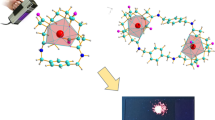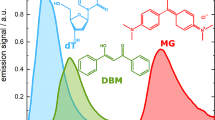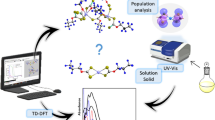Abstract
The emission spectra of Ru(bipy)2 (dppx)2+ in different environments has been studied. It was found that the solvent polarity and the ability of donating and transferring proton are the important factors in predicting luminescence intensity in different systems. The increasing content of water in the organic solutions of Ru(bipy)2 (dppx)2+ leads to decrease in emission intensity that follows the Perrin sphere of quenching model. The effect of base content of DNA on the fluorescence spectra of Ru (bipy)2 (dppx)2+ has also been studied.
Similar content being viewed by others
References
Friedman A E, Chambron J C, Sauvage J P,et al. Molecular “Light Switch” for DNA: Ru (bpy)2 (dppz)2+.J Am Chem Soc, 1990,112:4960–4962.
Friedman A E, Kumar C V, Turro N J,et al. Luminescence of Ruthenium (II) Polypyridyls: Evidence for Intercalative Binding to Z-DNA.Nucl Acid Res, 1991,19:2595–2601.
Hartshorn R M, Barton J K. Novel Dipyridophenazine Complexes of Ruthenium (II): Exploring Luminescent Reporters of DNA.J Am Chem Soc, 1992,114:5919–5925.
Liu J G, Ye B H, Chao H,et al. Luminescence Retrieval of Ru (byp)2 (HNOIP)2+: A Novel Molecular “Light Switch” for DNA.Chemistry letters, 1999, 1085–1086.
Moucheron C, Mesmaeker A K, Choua S. Photophysics of Ru(phen)2 (PHEHAT)2+: A Novel “Light Switch” for DNA and Photo-Oxidant Mononucleotides.Inorg Chem, 1997,36:584–592.
Zou X H, Ye B H, Li H,et al. The Design of New Molecular “Light Switches” for DNA.J Biol Inorg Chem, 2001,6: 143–150.
Holmlin R E, Barton J K. Os (phen)2 (dppz)2+: A Red-Emitting DNA Probe.Inorg Chem, 1995,34:7–8.
Hiort C, Lincoln P, Norden B. DNA Binding of Δ- and Λ-[Ru (phen)2dppz]2+.J Am Chem Soc, 1993,115:3448–3454.
Haq I, Lincoln P, Suh D,et al. Interaction of Δ- and Λ-[Ru(phen)2dppz]2+ with DNA: A Calorimetric and Equilibrium Binding Study.J Am Chem Soc, 1995,117:4788–4796.
Dupureur C M, Barton J K. Use of Selective Deuteration and1H NMR in Demonstrating Major Groove Binding of Δ-[Ru(phen)2dppz]2+ to d(GTCGAC)2.J Am Chem Soc, 1994,116:10286–10287.
Olson E J C, Hu D, Hormann, A,et al. First Observation of the Key Intermediate in the “Light Switch” Mechanism of [Ru(phen)2dppz]2+.J Am Chem Soc, 1997,119:11458–11467.
Ling L S, He Z K, Song G W,et al. Determination of DNA by Use of the Molecular “Light Switch” Complex of Ru(bipy)2(dppz)2+.Microchim Acta, 2000,134:57–62.
Ling L S, He Z K, Song G W,et al. High Sensitive Determination of DNA by Use of Molecular “Light Switch” Complex of Ru(phen)2(dppx)2+.Anal Chim Acta, 2001,436: 207–214.
Ling L S, Song G W, He Z K,et al. A Novel Method to Determine DNA by Use of Molecular “Light Switch” of Ru (phen)2(dppz)2+.Microchem J, 1999,63:356–364.
Ling L S, Song G W, He Z K,et al. A Novel Method for Determination of DNA by Use of Molecular “Light Switch” Complex of Ru (bipy)2(dppx)2+.Anal Chim Acta, 2000,403:209–217.
Chen F, Huang J P, Ai X P,et al. Determination of DNA by Rayleigh Light Scattering Enhancement of Molecular “Light Switches”.Analyst, 2003,128:1462–1466.
Ling L S, He Z K, Zeng Y E. spectral Studies on the Interaction of DNA and Ru(bipy)2 (dppx)2+.Spectrochim Acta Part A, 1999,55:1297–1302.
Knmlet M J, Abboud, J L M, Taft R W. An Examination of Linear Solvation Energy Relationships.Prog Phys Org Chem, 1981,13:485–630.
Cheng N L.Solvents Handbook. 3rd ed. Beijing: Chenical Industry Press, 2002. 298–330 (Ch).
Turro C, Bossmann S H, Jenkins Y,et al. Proton Transfer Quenching of the MLCT Excited State of Ru (phen)2 dppz2+ in Homogeneous Solution and Bound to DNA.J Am Chem Soc, 1995,117:9026–9032.
Valeur B.Molecular Fluorescence: Principles and Applications. Weinheim (Federal Republic of Germany): Wiley-VCH Verlag GmbH, 2001. 84.
Nair R B, Clullum B M, Muphy C J. Optical Properties of [Ru(phen)2dppz]2+ as a Function of Nonaqueous Environment.Inorg Chem, 1997,36:962–965.
Author information
Authors and Affiliations
Corresponding authors
Additional information
Foundation item: Supported by National Natural Science Foundation of China (20275028) and the National Key Basic Research and Development Program (973 Program 2002CB211800).
Biography: CHEN Fang (1975-), female, Ph. D., research direction: bioanalysis.
Rights and permissions
About this article
Cite this article
Fang, C., Xin-ping, A. & Zhi-ke, H. Optical properties of Ru(bipy)2(dppx)2+ in different environments. Wuhan Univ. J. Nat. Sci. 10, 904–908 (2005). https://doi.org/10.1007/BF02832436
Received:
Issue Date:
DOI: https://doi.org/10.1007/BF02832436




